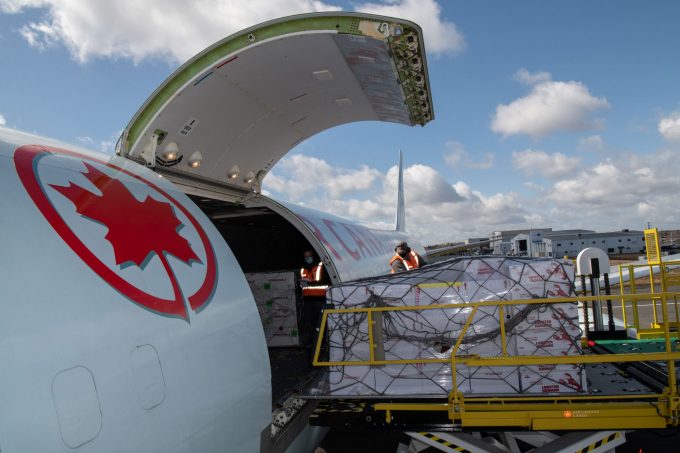Air Canada Cargo boosts North American freighter operations
Air Canada Cargo (AC) has added Chicago to its network of places served with freighter ...
TFII: SOLID AS USUALMAERSK: WEAKENINGF: FALLING OFF A CLIFFAAPL: 'BOTTLENECK IN MAINLAND CHINA'AAPL: CHINA TRENDSDHL: GROWTH CAPEXR: ANOTHER SOLID DELIVERYMFT: HERE COMES THE FALLDSV: LOOK AT SCHENKER PERFORMANCEUPS: A WAVE OF DOWNGRADES DSV: BARGAIN BINKNX: EARNINGS OUTODFL: RISING AND FALLING AND THEN RISING
TFII: SOLID AS USUALMAERSK: WEAKENINGF: FALLING OFF A CLIFFAAPL: 'BOTTLENECK IN MAINLAND CHINA'AAPL: CHINA TRENDSDHL: GROWTH CAPEXR: ANOTHER SOLID DELIVERYMFT: HERE COMES THE FALLDSV: LOOK AT SCHENKER PERFORMANCEUPS: A WAVE OF DOWNGRADES DSV: BARGAIN BINKNX: EARNINGS OUTODFL: RISING AND FALLING AND THEN RISING

On the face of it, the second quarter has been a poor one for Air Canada Cargo (AC), seeing a 24% year-on-year drop in revenue, to C$227m (US$167.7m)
Matt Casey, MD commercial of the airline’s cargo division, said the comparison with an “abnormal” 2022 was flawed, as loads and yields around the world were in the stratosphere then, thanks to elevated demand and disrupted ocean and ground supply chains.
He added: “It’s not that terrible compared with 2019.”
Moreover, the Canadian carrier fared a lot better than many airlines in Q2, including larger cargo players like Lufthansa and Korean Air, which suffered steeper declines.
Indeed, among the Asian carriers, Korean reported cargo revenue down 56%, to $748.8m, while All Nippon Airways freight turnover dropped 60%. In Europe, IAG and Air France KLM saw cargo revenues slip 32% and 34%, respectively, while Lufthansa Cargo turnover fell 45%, operating profit plunging 92% year on year.
And for the three US carriers the quarter was equally disappointing, with cargo revenue falling 37% at both Delta and United, and American’s down 39.8%.
However, the rapid growth in the passenger business compensated amply: United reported a 17% rise in overall revenues, to $14.2bn, and record net income of $1.7bn for the quarter.
Mr Casey noted that AC’s freight revenue decline was exacerbated by it still operating transpacific flights with passenger planes a year earlier. In the main, though, the Canadian carrier has struggled with the same headwinds as most others. Tepid demand in a weak global economic climate and the absence of tailwind from supply chain disruptions like port congestion have weighed on airline load factors further ravaged by the rapid increase in bellyhold capacity as airlines ramped up passenger flying.
And he attributes the comparatively mild decline in AC cargo revenue primarily to the deployment of the airline’s freighter contingent, explaining: “We had the ability to deploy them in the right places.”
In the main, this meant fielding its B767 freighters in “areas that were a little more isolated from the downturn in global demand”.
Latin America has been the biggest focus. There, AC has stepped up freighter flights to Mexico City and introduced a weekly flight to Punta Cana. It also serves San José, Bogotá, Lima, Quito and San Juan, flows that also feed its intercontinental network, such as passenger flights to Europe. Leveraging the global network has been a key element of the airline’s cargo strategy.
The North Atlantic has seen a surge in belly capacity, hitting load factors and yields. Still, AC has pressed ahead with recent freighter flights to Basel and Liege, which have been good markets for cargo, Mr Casey said.
“To Asia, we’re still lacking capacity,” he said. The airline will launch flights to Bangkok this autumn, and Singapore flights are planned for next year. And while AC has sufficient capacity to Japan, Korea and Hong Kong, its presence in Shanghai is still down to four weekly flights, with no indication of an increase.
The cargo division has used the slow market conditions to put newly acquired converted freighters through maintenance checks and repainting, and kept aircraft for back-up to safeguard schedule integrity. By the start of the peak season, those planes should be back in action, alongside the latest B767-300 freighter, set to join its fleet before the end of September.
Mr Casey hopes that the market will regain some strength by then, but he does not expect a dramatic surge.
“Nobody expects a rebound or an impressive peak,” he said. “There is hope that by Q2 next year, the market will improve.”
Comment on this article